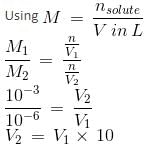Gujarat TET Paper 2: Science and Mathematics Test - 9 - Gujarat TET MCQ
30 Questions MCQ Test - Gujarat TET Paper 2: Science and Mathematics Test - 9
Points A and D are on the same side of line segment BC such that ∠ABC = 90°, ∠DCB = 90° and AB = DC. Then,
"Mapping" in the primary mathematics can be used in-
| 1 Crore+ students have signed up on EduRev. Have you? Download the App |
Identify the INCORRECT statement about rust.
The smallest value of 'y' in the number 9y8071 so that it is divisible by 11 is
Which cell organelle is found only in an animal cell?
In the standard form, the number 829030000 is expressed as k x 10n. The value of k + n is
The number of diagonals of a polygon having 12 sides is :
In a circuit, four resistors each of 12 Ω are connected in parallel to a 12-volt battery. What is the equivalent resistance of the circuit?
The haemoglobin is found exclusively in
In the figure, ABC is a triangle. What is the measure of ∠ABD in degrees?
Aqueous solution of which of the following oxides will change the colour of blue litmus to red?
Which of the following is a sulphide ore?
The total cost of 90 articles is Rs. 5400. If 70 such articles are sold at a total price of Rs. 5040, then there is
The process by which heat is transferred from the hotter end to the colder end of an object is known as ______.
Which of the following acid is used in car batteries?
If the number of sides of a regular polygon is 'n', then the number of lines of symmetry is equal to
How many times be a solution of pH = 3 diluted to get a solution of pH = 6?
One Astronomical Unit (AU) is equal to
Which one of the following tasks promotes critical thinking in a mathematical classroom?
a. Prove that your answer is correct.
b. Use manipulatives (blocks, tiles, etc.) to solve this problem.
c. Draw a picture to help me understand the problem.
d. Apply the formula and get the answer.
Which is the only nonmetal that reacts with air to form its oxide by burning?
Which of the following is not among various qualities of processes of scientific inquiries?
A very common error observed in addition of linear expression is 5y + 3 = 8y. This type of error is termed as
For preparation of a lesson plan in Herbart approach, the right order of steps to be followed is
To enhance professional competencies and skills, the science teacher participates in seminars, workshops, orientation classes, visits science centres and science fair programs. This role of the science teacher is to act as a/an
Which of the following activities will help teachers to implement problem solving in their classrooms?
Which of the following is NOT a herbivore?
Which type of evaluation is suitable to find out the specific weaknesses of students’ learning?
Which of the following is not a component under stimulus-variation skill?
While teaching the correct method of reading a clinical thermometer to class VIII students, Neha mentions the following necessary precautions to be taken.
Which of the given precautions has been mentioned wrongly by the teacher?
Which of the following is not a demerit of project method?



















